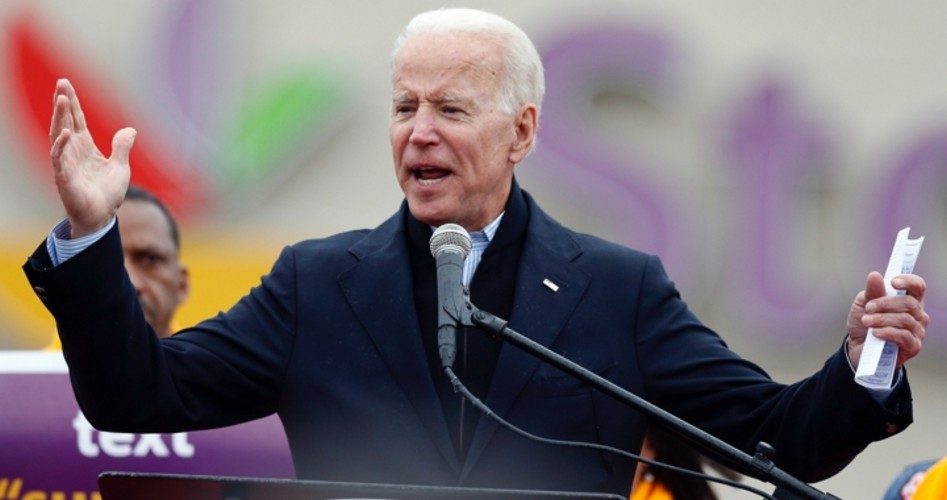
Two days from now, Joe Biden will announce his candidacy for president.
But right after The Atlantic disclosed the date of Biden’s announcement, the New York Times sallied forth with this question: “Should a White Man Be the Face of the Democratic Party in 2020?”
So Biden might have something of a problem taking the nomination in a party increasingly under the control of a coalition of women, minorities, and homosexuals.
Then again, the polling data show otherwise. Biden, as The New American has reported, has a commanding lead over all his competitors, including notably the minority and women candidates who inspired the question the Times asked.
The Big Question
The central question of the Times piece? What would hurt the Democrats more: nominating a white man, or nominating a minority or woman candidate.
Is a white man the best face for an increasingly diverse Democratic Party in 2020? And what’s the bigger gamble: to nominate a white man and risk disappointing some of the party’s base, or nominate a minority candidate or a woman who might struggle to carry predominantly white swing states like Wisconsin, Michigan and Pennsylvania that both Barack Obama and President Trump won?
Thus, the Times found a 64-year-old woman who wanted “to see a minority or female candidate catch fire, and worries that nominating a white man could cause some liberals to skip voting in November 2020.”
“I consider myself a centrist, middle-of-the-road Democrat,” she told the Times at an event for Senator Cory Booker. “And the progressive side worries me. What are they going to do? Are they going to sit it out if they don’t like the top candidate?”
The Times spoke to one sensible voter who thinks Biden is “the most electable,” and that “nominating its first white man since John Kerry in 2004,” as the Times put it, would not harm the party’s chance of victory in 2020.
Problem is, the Times averred, old white guys “are out of step with ascendant forces in the party today” because “women, minorities and young people are fueling much of its energy, and they are well represented by multiple well-qualified, politically savvy female and nonwhite Democrats who are running.”
And so the Times turned to retired bookkeeper Diane Henning, who “said it would be a mistake for Democrats to nominate a white man in 2020” because, she told the newspaper, “there are so many good women out there who could do the job.”
Defeat Trump
Maybe, but whether a woman can do the job isn’t the point. The point is beating Trump, and it appears that rank-and-file Democrats don’t believe any of the radical candidates, including the media’s new star, Pete Buttigieg, can defeat Trump.
That’s why the Real Clear Politics polling data, going back to October, show Biden way ahead of his competitors. Another old white guy, communist apologist Bernie Sanders, is the closest to Biden.
So the Democrats have a problem. The media and radical Left are pushing for a fringe candidate, a minority or woman or both, who will likely lose the same states that Hillary Clinton lost in 2016, which almost certainly guarantees a Trump victory.
Consider not just the polling data that show Biden the favorite, but the demographic data on party affiliation. Last year, the Pew research organization reported, 51 percent of registered voters were Republicans, while 43 percent were Democrats.
In 2016, 74 percent of voters were white, 54 percent of whom went for Trump. If the fringe coalition that firmly controls the party insists on a candidate those voters perceive as too radical, they might well ensure another Trump victory. Rank-and-file Democrats, even those who voted for Clinton, might head to MAGA country. Voters who cast a ballot for Obama might again go for Trump.
In other words, “moderate” Democrats, such as they are, are right to worry that 2020 might be another 1972, when the kook Left took over the party and nominated a candidate who went down in flames.
As for Biden, he will launch his third campaign on Wednesday. His first effort ended when the media revealed him to have plagiarized a law-school review article and a speech from British radical laborite Neil Kinnock. In 2008, he withdrew from the race for the nomination after a crushing defeat in the Iowa caucuses. He landed at 0.9 percent of the vote behind Obama, Clinton, John Edwards and Bill Richardson.
Photo: AP Images


